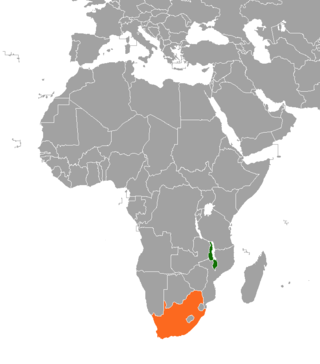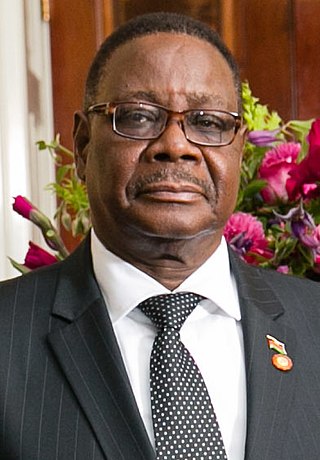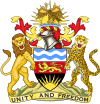
Malawi, officially the Republic of Malawi and formerly known as Nyasaland, is a landlocked country in Southeastern Africa. It is bordered by Zambia to the west, Tanzania to the north and northeast, and Mozambique to the east, south and southwest. Malawi spans over 118,484 km2 (45,747 sq mi) and has an estimated population of 19,431,566. Malawi's capital and largest city is Lilongwe. Its second-largest is Blantyre, its third-largest is Mzuzu and its fourth-largest is its former capital, Zomba. It was the first capital city of Malawi before being changed to Lilongwe.
The History of Malawi covers the area of present-day Malawi. The region was once part of the Maravi Empire. In colonial times, the territory was ruled by the British, under whose control it was known first as British Central Africa and later Nyasaland. It becomes part of the Federation of Rhodesia and Nyasaland. The country achieved full independence, as Malawi, in 1964. After independence, Malawi was ruled as a one-party state under Hastings Banda until 1994.

Politics of Malawi takes place in a framework of a presidential representative democratic republic, whereby the President of Malawi is both head of state and head of government, and of a multi-party system. Executive power is exercised by the government. Legislative power is vested in both the government and the National Assembly. There is a cabinet of Malawi that is appointed by the President of Malawi. The judiciary is independent of the executive and the legislature.

Hastings Kamuzu Banda was the leader of Malawi from 1964 to 1994. He served as Prime Minister from independence in 1964 to 1966, when Malawi was a Dominion / Commonwealth realm). In 1966, the country became a republic and he became the first president as a result, ruling until his defeat in 1994.

Bingu wa Mutharika was a Malawian politician and economist who was President of Malawi from May 2004 until his death in April 2012. He was also President of the Democratic Progressive Party, which he founded in February 2005; it obtained a majority in Malawi's parliament in the 2009 general election.

John Zenus Ungapake Tembo was a Malawian politician who served for years as President of the Malawi Congress Party (MCP). Tembo comes from the Dedza District in central Malawi, and he was a teacher by profession. Beginning in the 1960s he was an important politician in Malawi, and he was a key figure in the regime of Hastings Banda (1964–1994). He has been variously described as "physically slight, ascetic, fastidious" and "cunning". He was replaced as President of the MCP in August 2013.
Yatuta Chisiza was a Malawi minister of home affairs who led a brief guerrilla incursion into the country in October 1967. He is considered one of the most important figures in pre and post colonial politics in Malawi.

The Kamuzu Stadium is a multi-purpose stadium in Blantyre, Malawi. It is currently used mostly for football matches. The stadium holds 65,000 people. This can be limited for safety reasons. Big Bullets and Be Forward Wanderers are tenants.

Joyce Hilda Banda is a Malawian politician, who served as President of Malawi, from 7 April 2012 to 31 May 2014. Banda took office as President following the sudden death of President Bingu wa Mutharika. She is the founder and leader of the People's Party, created in 2011. An educator and grassroots women's rights activist, she was the Minister of Foreign Affairs from 2006 to 2009 and the Vice-President of Malawi from May 2009 to April 2012. She has served in various roles as a member of Parliament and as Minister of Gender and Child Welfare before she became the President of the Republic of Malawi.

Malawian-South African relations refers to the bilateral relationship between Malawi and South Africa. South Africa's first formal relationship with an independent African country was established with Malawi, beginning in 1967.
Billy Abner Mayaya is a Malawian human rights activist, artist, poet and theologian.

Arthur Peter Mutharika is a Malawian politician and lawyer who was President of Malawi from May 2014 to June 2020. Mutharika has worked in the field of international justice, specialising in international economic law, international law and comparative constitutional law. He informally served as an adviser to his older brother, President Bingu wa Mutharika, on issues of foreign and domestic policy from the onset of his election campaign until the President's death on 5 April 2012.
The Malawi Young Pioneers (MYP) were the paramilitary wing of the Malawi Congress Party. Their Commander-in-Chief was President Hastings Kamuzu Banda. They originally were supposed to function as a national youth service program with a development agenda. However over time, they strayed away from this agenda and became an intricate network of espionage and terror. The Young Pioneers were a major instrument for the operationalisation of Dr Banda's one-party totalitarian dictatorship and domestic terrorism. Pioneers bore arms, conducted espionage and intelligence operations, and were Banda's most trusted bodyguards around Hastings Kamuzu Banda. Both the Malawi Army and Police resented the Pioneers for usurping their roles as security agents.

Eta Elizabeth Banda is a former Malawian politician who was the country's Minister of Foreign Affairs from 2009 to 2011. Prior to entering politics, she worked as a health professional and university administrator.
The 2011 Malawi protests were protests aimed at winning political and economic reforms or concessions from the government of Malawi. On 20 July, Malawian organisations protested against perceived poor economic management and poor governance by President Bingu wa Mutharika and his Democratic Progressive Party. After the first two days of protests, 18 deaths, 98 serious injuries and 275 arrests had been reported. Further demonstrations were organised on 17 August and 21 September The first protest was later cancelled due to the intervention of a UN representative in initiating a dialogue; however, the talks broke down with more protests planned for Red Wednesday through a national vigil.
The 2012 Malawian constitutional crisis occurred from April 5, 2012 - April 7, 2012 after senior members of the Democratic Progressive Party-led cabinet failed to notify the public of the death of the sitting president, Bingu wa Mutharika on April 5. Instead, cabinet ministers held a series of meetings in Lilongwe, Malawi without vice-president Joyce Banda with the aim of undermining the constitution and Banda's succession to Presidency. News confirming his death had, however, quickly spread across the country through word of mouth, cellphone text messages, Malawian bloggers, Twitter, Facebook, and on listservs by the end of the day on April 5, 2012. Therefore, the failure to announce his death resulted in speculation over the real health of the president and over whether the succession procedures would be followed as outlined in the constitution. According to the constitution, the vice-president takes over but there had been no official word on a successor or communication with the vice-president. Amidst growing speculation, the Cabinet announced that the president's brother, Peter Mutharika, the foreign minister, was the new President of the party on April 6. The Cabinet only announced his death two days after his death, after which Banda became Malawi's first female President.
General Henry Odillo was Commander of the Malawian Defence Force. He was appointed as the commander General of Malawi defence force in July 2011 after the nationwide protests against Bingu wa Mutharika's presidency in which wa Mutharika accused the organizers of the protest of plotting a coup against him. He replaced General Marko Chiziko. Prior to this appointment he served as the military attache at the Malawi High Commission in London. General Odillo was dismissed by Malawi's new President Arthur Mutharika in June 2014. President Mutharika promoted Major-General Ignacio Maulana to the rank of General and appointed him the new Commander of the Army.
Marko Chiziko was the former Commander General of the Malawian Defence Force (MDF). He was born in Dowa at Chiziko Village, Chakhaza Traditional authority.
Kamuzu Barracks Football Club are a Malawian football (soccer) club based in Lilongwe and currently playing in the TNM Super League, the top division of Malawian football.

Kamuzu Mausoleum is a resting place of the first president of Malawi, Dr. Hastings Kamuzu Banda situated within Kamuzu Memorial Park. The monument holds historical significance and is dedicated to the late President Kamuzu Banda, who led Malawi to independence. Banda was born on 14 May 1898 and ruled from 1961 to 1994. He died on 25 November 1997 at the age of 99.














